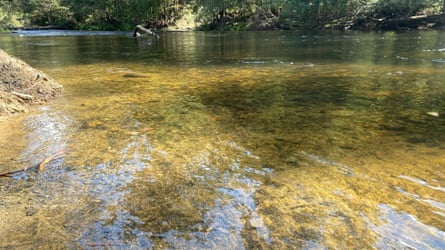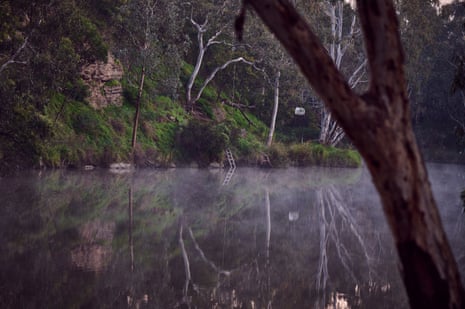In 2017, on a hot March day, I went looking for azure kingfishers. Tiny, elusive and even bluer than their name suggests, they’d been seen several times on the Yarra River in the outer north-eastern suburbs of Melbourne.
I rode to the river from Lilydale station along the busy roads that pulled like taut wire between the paddocks and empty lots out there, nearly crashing at the bottom of a fast, steep hill while cars and trucks whooshed past me.
I made it to the river eventually but I never found the kingfishers, and unwilling to go back the way I came, I decided instead to ride back along the river. I wasn’t dressed for a long ride – I was wearing jeans – and as I couldn’t find a direct path along the river, I found myself detouring until I was almost lost, at the foot of a steep hill.
It was mid-afternoon and the sun stayed high and hot for hours, barely seeming to move. I grew more and more tired and disoriented. It probably took me no more than an hour of riding but it felt like much longer by the time I finally made it back into something that seemed like the Melbourne I knew: Warrandyte, still far from any train station and even further from home. And as if in a dream, I found a remarkable sight: hundreds of people, swimming and bathing in a wide, sparkling stream. I dismounted and took off my helmet and, scooping up handfuls of fresh, clean water I splashed them over my head, washing the sweat away and cooling myself down. It felt beautiful.
I assumed this clear stream, full of people, must be some larger creek or secondary river I wasn’t familiar with. So when I eventually got home and looked up where I’d been, I was astonished by what the map told me: I’d washed my face in the Yarra River.

I grew up swimming in fresh water. The nearest sea beach was a two-hour drive from my home, but Canberra’s Lake Burley Griffin was just a few blocks away. Swimming in the lake was a thing Canberrans did then, in the 1980s and 1990s. Or else swimming in the Cotter River, or the Molonglo River, or the Murrumbidgee, amid water-curved rocks and coarse sand and casuarinas.
I never learned how to spot a rip in the ocean but I learned not to dive to the bottom of rivers lest I get caught in a snag, not to swim in a river after heavy rain, that water in a river is heavier and faster than it looks and that a fast-flowing river can carry you away and drag you under before you even know what’s happening. I learned the feel of algae and mud between my toes before the river bottom dropped away; I learned how to walk across submerged rocks, gritting my teeth against stubbed toes as the water rose coldly over my knees, over my belly, over my chest, and my pale skin disappeared into the dark tanniny stream. I learned about the shock or welcome relief of pockets of cold water beneath the surface.
I’ve never been much of a swimmer but the swimming I did always seem at odds with what I was told, again and again, was the Australian way: golden, sandy beaches and saltwater spray and crashing waves. To this day I can’t quite get my head around the appeal of swimming in sea water only to then have a shower. If you’ve ever swum in a healthy river, or a healthy lake, then you know the feeling of coming out cleaner than you were when you went in. There’s no other swimming like it.
But not every river is swimmable – and as a whole, Melburnians don’t embrace their largest river. Sure, people use the Yarra – they row on it, they walk along it – but it won’t be long before you hear it called, derisively, “the upside-down river”, because of its cloudy, clay-filled water; and if you mention you’ve enjoyed spending some time along its banks, it won’t be long before some wag asks if you saw any bodies floating by.

And these detractors have a point: until recently, in the history of the city of Melbourne, the Yarra’s been treated as nothing better than a drain, and often as something considerably worse. Along its length you’ll have no trouble finding rubbish floating on its surface or caught in the vegetation on its banks, and rubbish traps choked with all the refuse of a city of five million people. Any pleasant view of the Yarra is only a bend in the river away from being ruined by a pile of floating garbage, and the river’s banks are havens for environmental weeds of all kinds.
But it’s a lot better than it used to be. Consider this passage from Kristin Otto’s Yarra: A Diverting History:
There were slaughterhouses or abattoirs, along with every conceivable sidebar business, up to Dights Falls: fellmongers to prepare the animals’ fresh, bloody skins for tanneries to make leather on the open ground; wool scourers to wash the fleece (in the ‘fresh’ water on the riverbanks); starch and glue factories and bone mills, to process hooves and horns; candle and soap factories. And all the unusable waste – heads, legs, megalitres of gross liquid – emptied into the flow … Water taken from the Pumps at one point was described as having the consistency of very weak gelatine. In its lower reaches, the Yarra was a vomit-inducing sewer.
The hoary old saying tells us that we can’t step in the same river twice, and it’s true the Yarra has constantly changed – and more to the point, been changed – throughout Melbourne’s history. But so deplorable has been Melbourne’s treatment of its main river that the city seems, collectively, to have forgotten that things can be changed for the better as well as for the worse. The Yarra has been abused for so long that as a community we’ve forgotten how to treat it any other way.

Although I’ve been in Melbourne now for nearly half my life, I still struggle to think of myself as a Melburnian: I don’t follow the footy; I don’t know where half the suburbs are; I don’t understand most of the shibboleths. I cling to Canberra, my home town. But that changes when I’m by the Yarra: that old, slow river makes me feel more connected to Melbourne than anything else ever has. When I first started falling in love with the Yarra I got my wires crossed and I thought its muddy colour was natural – but I subsequently read that the muddiness of the river as we know it now is a result of erosion along its banks and the banks of its tributaries, and that that erosion was in turn a result of widespread land clearing since European colonisation. Before this process all began, so it’s said, the Yarra ran clear.
I don’t know whether that’s true or not, but it’s a jarring thought, and it should shake us out of how we regard the Yarra that we know now. And it should prompt us to ask ourselves, and the Melburnians around us: if the Yarra once ran clear from its source to its mouth, what would it be like to live once again along a clear-flowing river?
This is an edited extract from A Clear Flowing Yarra by Harry Saddler, out 29 August with Affirm Press
